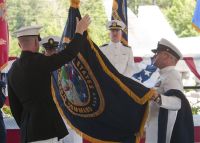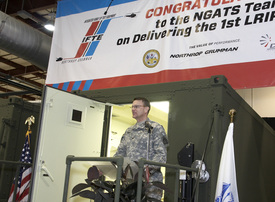WASHINGTON, June 30, 2011 — U.S. Joint Forces Command marked two more steps toward its disestablishment today as it transferred its Joint Warfare Analysis Center to U.S. Strategic Command and its Joint Enabling Capabilities Command to U.S. Transportation Command.
Today’s transition ceremonies at Dahlgren, Va., and Joint Forces Command’s Joint Warfighting Center in Suffolk, Va., respectively, represented the latest in a continuing effort to realign the command’s functions and generate greater efficiencies within the Defense Department.
The Joint Warfare Analysis Center provides comprehensive technical analyses on a wide array of national security challenges and issues. This support helps inform and support decision makers involved in combat operations as well as high-level policy-making sessions, command officials said.
The Joint Enabling Capabilities Command provides immediate, short-duration support to establish, organize and operate joint force headquarters across the globe, officials explained. It brings capability and expertise in plans, operations, logistics, information superiority, knowledge management, communications and public affairs.
All affected elements will remain at their current locations. The Joint Warfighter Analysis Center is based in Dahlgren and the JECC headquarters, as well as its Joint Deployable Team and Joint Public Affairs Support Element, in Hampton Roads, Va. The JECC’s Joint Communications Support Element is at MacDill Air Force Base in Tampa, Fla.
Both the JWAC and JECC commanders offered assurances that their support will continue uninterrupted during the transition, the most recent at Joint Forces Command.
Joint Forces Command transferred its Joint Capability Development Directorate to the Joint Staff June 1. The directorate is now known as the deputy director for command and control, communications and computers with responsibility for overseeing C4 processes and initiatives.
On May 20, Joint Forces Command’s Joint Unmanned Aircraft System Center of Excellence at Creech Air Force Base, Nev., transferred to the Joint Staff’s Force Structure, Resources and Assessment Directorate. The center’s staff focuses on standardizing, integrating and training joint warfighters for unmanned aircraft systems and their products.
Defense Secretary Robert M. Gates, who retired today, announced in August that he would recommend eliminating Joint Forces Command and assigning its essential functions to other organizations. With the depth of joint experience now established in the services through experience in Afghanistan, Iraq and around the world, Gates said the department no longer needs a four-star combatant command specifically focused on joint training, doctrine and operations.
President Barack Obama approved Joint Forces Command’s disestablishment Jan. 6.
Army Gen. Raymond T. Odierno, commander of Joint Forces Command, said last month at the 2011 Joint Warfighting Conference that the services must encourage young leaders to embrace the principles advanced at the command.
“We need leaders with vision. We need leaders willing to tackle these difficult issues,” he told the forum. “We need leaders who will do what’s better for our force as a whole and not focus internally on their own service … It’s ultimately about achieving greater effectiveness in national security while acting more efficiently.”
Odierno told reporters earlier this year he was committed to completing the reorganization in a way that doesn’t compromise critical capabilities.
“What I hope to see is that we’re able to do our job better to support combatant commands in the services as they request help,” he said, “whether it’s conducting training exercises around the world or developing new doctrines for Afghanistan or ballistic missile defense or other areas.”
Obama nominated Odierno last month to become the next Army chief of staff. The president also named Army Lt. Gen. Keith Huber, Joint Forces Command’s deputy commander, to serve as commander of Joint Task Force 435 in Afghanistan.
(Editor’s Note: Army Sgt. Josh LeCappelain of Joint Forces Command Public Affairs Office and Whitney Williams from Joint Enabling Capabilities Command contributed to this article.)
Source:
U.S. Department of Defense
Office of the Assistant Secretary of Defense (Public Affairs)

 von
von 
